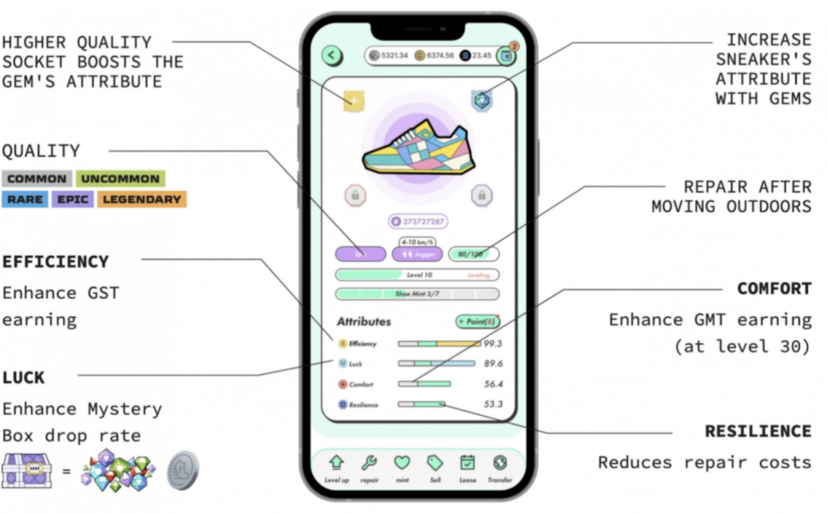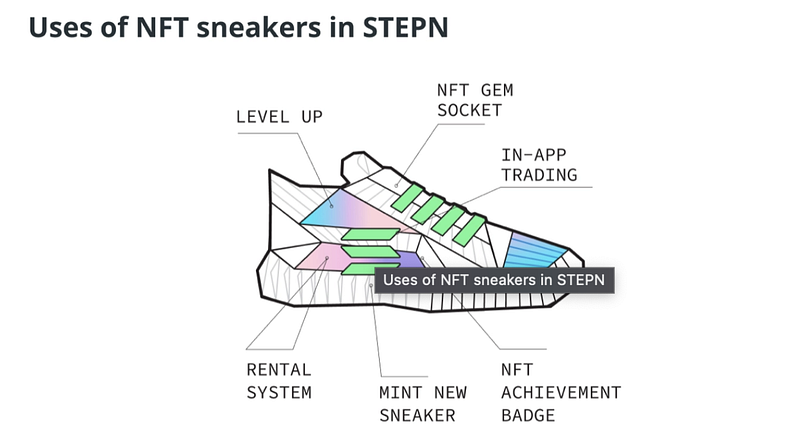
StepN is a Web3 lifestyle app with Social-Fi and Game-Fi elements that allows players to earn by walking, jogging or running outdoors with an NFT sneaker. Let’s try and find out what’s there to praise and criticise.
What’s the story?
StepN was developed by Find Satoshi Lab, an Australian fintech firm. Jerry Huang and Yawn Rong are the co-founders of StepN. First, the app took home the prize from The Solana Ignition Hackathon Gaming Track, then it secured a $5 million seed round, with Solana Capital, DeFi Alliance, MorningStar Ventures, Sequoia Capital and others among leading investors.
StepN’s main goal is to inspire millions of people to live healthier lives by connecting them to Web3 and helping them to achieve carbon neutrality. Since its launch last December, it has attracted two to three million active users monthly. Of course, it’s far from the hundred-million player size enjoyed by popular Web 2.0 titles, but in the world of crypto, it’s a meaningful breakthrough for such a young app.
The fast-growing app appears to be self-sustainable for now. It’s generating $3 million-$5 million in net profit from trading fees a day and earning up to $100 million every month. In April, it got another round of strategic investment from Binance.
Enough of history, let’s dig into the app, see how it works and think of the reasons why it’s getting criticism from the crypto community.
How does StepN work?
First, users need to download the StepN app, register with their email address and connect the wallet to explore StepN cryptocurrency.
NFTs are sneakers worn by the users in StepN’s Game-Fi system. You can buy sneakers by depositing SOL token in the in-app wallet, and then wait for their energy to be replenished after 24 hours. The number of minutes a user may exercise with a sneaker NFT is measured in energy. Resilience, efficiency and comfort are the attributes that users may select. The features of your sneaker all contribute to its energy cap. The energy cap is significant in bottlenecking distribution because the supply of rewards is restricted.
There are two types of tokens that exist in the StepN ecosystem: the Green Satoshi Token (GST) which is the game’s utility token, and has an unlimited supply, and then there is Green Metaverse Token (GMT) which is the governance token. The supply of GMT tokens are limited to 6 billion.
In April both tokens reached their all-time high of $4.11 for GMT $8.51 for GST respectively. Then the prices cooled off. But last Thursday, StepN posted on Twitter that it would disconnect users with a GPS signal in mainland China to ensure it complied with Beijing’s rules. This sent GMT tumbling to $1.13, according to CoinGecko.
Users can sell/buy or lease/rent NFT sneakers, gems and badges on the marketplace and can earn game currency by jogging, walking or running outside, which can be cashed out for profit or utilized in-game. The marketplace has a simple filter and sort tool for quick navigation.

For instance, once your sneaker is ready, you can begin running and earning GST utility token rewards (rewards are distributed of the 30% of the supply that is set aside for this purpose). However, please note that StepN has yet to operationalize the rental and the credit system.
Due to the limited quantity of tokens, a burn mechanism is required to help people live a healthy lifestyle. Through different in-app actions, the burn mechanism is used to reduce the circulation of both GMT and GST.
Users can access three StepN gameplay features, the solo, marathon and background modes, to earn money and freely participate in the game. In solo mode, users move around wearing NFT sneakers to earn GST tokens, but Energy is required to earn these tokens. Five minutes of ‘move & earn’ is supported by 1 unit of Energy, which can be recharged by purchasing an NFT sneaker. There is also an option to participate in weekly or monthly marathons by registering under the “Marathon tab.” If users have at least one pair of sneakers, they can earn GST tokens offline and without repair charges using the background mode.
As we now understand how the app works, let’s speculate a bit whether it’s worth engaging with it or not.
What are the drawbacks of using StepN?
Some argue what makes StepN — and other play-to-earn blockchain games like Axie Infinity — successful is the fact that they are essentially financial products with a gamified twist.
To start earning tokens and logging one’s mileage on StepN, users need to first spend at least 12 SOL or around $550 on a pair of virtual shoes at the current market rate. Not a trivial amount for any casual player.
Over time, StepN users will need to accumulate new kicks to level up. The usual return on investment requires about a month, upon which people can start generating income. So, the game can be quite lucrative.
The financial sustainability of play-to-earn is also in question. Maintaining this business model means the gameplay needs to be either so addictive that users continue to play without cashing out their coins, or that the app continues to attract new users who buy in only to replace those who’ve cash out. This allows us to compare the play-to-earn to pyramid schemes. For instance, Axie Affinity nosedived because it couldn’t sustain its quick raise.
StepN proposes a twofold solution to sustainability. For one, it’s working on a price stabilization mechanism to ensure the cost of its coins is always at a rate that the shoes are affordable for new users but also not so cheap that existing users lack the incentives to mint new shoes.
Price manipulation is achieved through its dual-token system. When the price of its “utility coin” GST is too high and shoes get pricey, StepN will ask players to burn its “governance coin” GMT to mint new shoes. The supply of GST increases as a result, leading to a sell-off and bringing its cost down.
Now you know almost everything you need about the new StepN app, it’s up to you to try it out or not. But overall, it seems like a brave and disruptive project, the challenge now is to prove that it can continue to draw in a constant stream of new runners, joggers and walkers.

